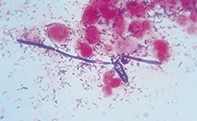Peer Reviewed
Feature Article Women’s health
Management of common vaginal discharges
Abstract
Mixed infections are common, and high vaginal and endocervical swabs for gonococcus and chlamydia should be taken from all patients presenting with a vaginal discharge.
Key Points
- Use of narrow range pH tape (pH 4.0 to 6.0) and 10% potassium hydroxide solution when evaluating a vaginal discharge is invaluable for the general practitioner.
- Bacterial vaginosis is the name of the syndrome formerly known as ‘gardnerella’. Despite treatment, bacterial vaginosis often recurs.
- Testing for bacterial vaginosis should occur before operative invasive gynaecological procedures. It should be treated before surgery, including termination of pregnancy.
- Symptomatic vaginal yeast infections may produce a range of clinical features, from vulval swelling and pain after intercourse, with no discharge, to the classical ‘cottage cheese’ discharge with vulval itching.
- Many skin conditions other than yeast infection cause vulval itching, and examination is always advisable. Fungal resistance to over-the-counter preparations may be increasing.
- Vaginal relapse and not reinfection is thought to be the cause of recurrent vaginal yeast infections, and this may be related to the immune system. Long term suppressive or maintenance therapy is recommended.
- Trichomonas vaginalis infection may be more common than previously realised, as more sensitive nucleic acid tests become available.
Purchase the PDF version of this article
Already a subscriber? Login here.

